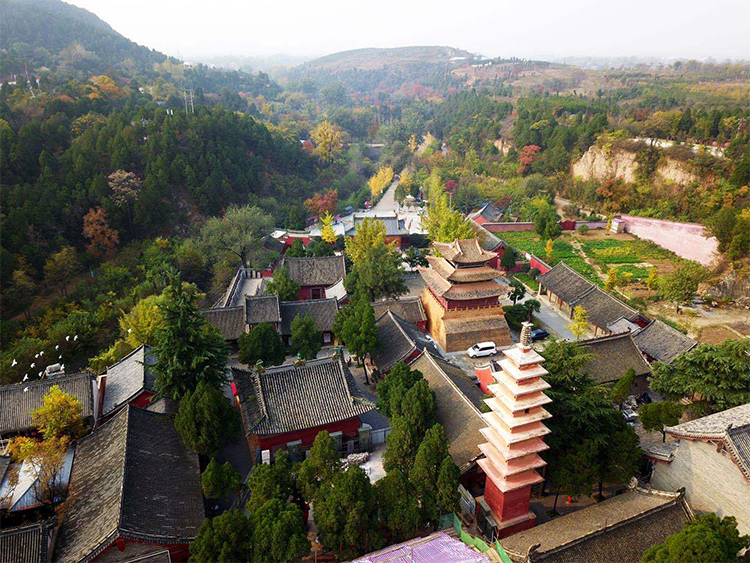Ancient Chinese Architecture at Fengxue Temple: Timeless Zen and National Treasures
Introduction
Morning mist threads through the pines on Fengxue Mountain, revealing an ancient temple nestled among cedars and cypresses. This is Fengxue Temple in Ruzhou — a Buddhist sanctuary more than 1,800 years old where Tang pagoda masonry, Song dynasty bronze bell tones, and the solemnity of a Jin-era main hall meet today’s sunlight. Entering the courtyard feels like stepping onto the rings of history: the Seven Ancestors Pagoda still holds echoes of Tang chants, the rust of the bell pavilion stores the sound of a northern capital’s mornings, and the eaves and brackets of the central hall show traces of Yingzao Fashi craftsmanship. More than one of the “three great Central Plains temples,” Fengxue is a living museum of ancient Chinese architecture, waiting for visitors to measure it by foot and converse with it in silence.
1. History: A Buddhist Treasure in the River of Time
One-line essence: The most intact millennium-old Buddhist complex in the Central Plains — a three-dimensional chronicle from the Eastern Han to today.
Fengxue Temple traces its origins to the first year of Jianping (190 AD) in the Eastern Han, shortly after Buddhism arrived in China. Built high in a wooded valley, it quickly became a center of worship. In the Tang dynasty the site reached its peak as the monastery of Chan master Shenhui, and the Seven Ancestors Pagoda was erected in his memory. Through the Song, Jin, Yuan, Ming and Qing dynasties, the temple’s incense never died out; successive repairs and additions accumulated like tree rings, recording the evolution of Chinese Buddhist art.
Unlike many temples rebuilt in modern times, Fengxue unusually preserves the original layout of its ancient building cluster. In 1988 it was designated a Major Historical and Cultural Site Protected at the National Level. Its value is both religious and architectural: the complex is a key to understanding traditional Chinese timber construction, Chan (Zen) practice, and regional history.
2. Three National Treasures: An Architectural Symphony Across Time
Seven Ancestors Pagoda (Tang dynasty)
The pagoda rises 24 meters with nine tiers of overlapping eaves, built in 738 (the 26th year of Kaiyuan). Despite earthquakes and war, it stands with austere dignity: no ornate carvings, only disciplined proportions and spare, layered eaves that express the grandeur of the high Tang. Up close, the lime mortar between bricks shows age and crazing, and the wind charms — the small wind bells on each tier — still ring faintly in the mountain breeze. These are Tang craftsmen’s “sound fossils.”
Bell Pavilion (Song dynasty)
The pavilion houses a Song-era iron bell weighing about 8,000 jin (roughly four metric tons). Its surface is inscribed with Sanskrit sutras. If you are there at dawn you may hear monks strike the bell; the vibration washes across the valley in ripples, giving birth to the famed “Fengxue bell sound.” The bell’s sonority makes the mountain itself part of the monastery’s liturgy.
Main Hall (Zhongfo Hall, Jin dynasty)
Jin-period timber buildings are rare in the Central Plains, and the single-eave xieshan-roofed Zhongfo Hall is textbook-perfect. The bracket sets, column bases and proportions follow the Song architectural manual Yingzao Fashi closely. Inside, remnants of original polychrome paint survive on beams and trusses; looking up at the painted caisson is like watching Jin-era carpenters assemble frames and sketch patterns with their hands.

3. Immersive Experiences: Dual Healing of Zen and Nature
– Morning bell and evening drum: Arrive before 6:00 a.m. to observe morning liturgy. Sutra chanting, joined with wooden fish and birdsong, forms a natural soundtrack for meditation.
– Eight scenic spots: The temple grounds include features such as the “Pearl Curtain” waterfall and the ancient “Great Mercy Spring” well. Walk the stone paths up to Jinping Screen Cliff to see Tang-era line-carved Buddha figures flowing across the rock face.
– Temple vegetarian fare: The refectory serves simple noodle bowls (about ¥10 each) made from the temple garden’s produce — clean, subtle flavors with a natural sweetness.
4. Practical Tips: How to Avoid Crowds and Travel Smart
– Best times: 07:00–09:00 or after 16:00 for soft light and fewer people — ideal for photography.
– Dress code: In summer, cover shoulders and knees out of respect; in winter, bring a windproof layer since the halls are unheated.
– Beware of tourist traps: Vendors outside the temple may sell “blessed” charms. Purchase ritual items only at the temple’s official store or from authorized monastic channels.
– Getting there:
– Taxi: About 20 minutes from Ruzhou city center (roughly ¥30). Set your destination as “Fengxue Temple mountain gate.”
– Bus: Take Ruzhou Bus No. 8 to “Fengxue Temple” stop, then a 15-minute uphill walk (cobbled path lined with ancient cypress trees — a ceremonial approach).

Conclusion
Time at Fengxue Temple is not a straight line. Tang bricks, Song iron and Jin timber breathe alongside today’s sunlight. When you touch the worn base of the Seven Ancestors Pagoda or sit quietly in the Zhongfo Hall and feel the corner bells tremble, you may realize the temple’s truest treasure is not the “national relic” label but its unforced authenticity. Like a silent elder, it needs no grand words — only your slowed pace to open a millennium-spanning dialogue.
Practical snapshot
Location: Fengxue Temple, Fengxue Mountain, Ruzhou, Henan Province
Best seasons: Spring and autumn for comfortable weather and clear mountain views
Entrance: Check local listings for seasonal opening hours and any preservation-related closures
Local tip: Combine the visit with other Central Plains heritage sites to appreciate regional architectural continuity.


